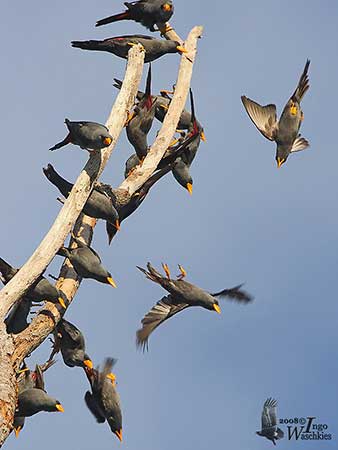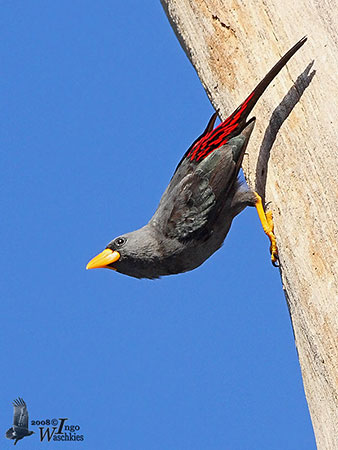
Fr: Scissirostre des Célèbes
Ang: Grosbeak Starling or Finch-billed Myna
All: Finkenschnabelstar
Esp: Estornino Culipinto
Ita: Maina fringillina
Nd: Roodstuitspreeuw
Sd: tjocknäbbad stare
Photographer:
Ingo Waschkies
Bird Photography
Text by Nicole Bouglouan
Sources:
HANDBOOK OF THE BIRDS OF THE WORLD Vol 14 by Josep del Hoyo-Andrew Elliot-David Christie - Lynx Edicions – ISBN: 9788496553507
STARLINGS AND MYNAS, by Chris Feare and Adrian Craig. Christopher HELM - ISBN: 071353961X
A Photographic Guide to the Birds of Indonesia De Morten Strange – Editeur: Princeton University Press, 2001 – ISBN: 0691114951, 9780691114958 – 416 pages
Wikipedia, the free encyclopaedia
Grosbeak Starling or Finch-billed Myna
Scissirostrum dubium
Passeriformes Order – Sturnidae Family
INTRODUCTION:
The Grosbeak Starling is the only member of genus Scissirostrum. It is endemic to Sulawesi.
This highly gregarious species feeds, flies and breed in flocks. It is found in open woodlands and at forest edges, from sea-level to 1,100 metres of elevation.
The Grosbeak Starling is described as common and widespread or locally abundant, and it is not globally threatened for the moment.
This species was first described in 1801 by John Latham, an English ornithologist.

DESCRIPTION OF THE BIRD:
Biometrics:
Length: 17-21 cm
Weight: 50 gr
The Grosbeak Starling has dark slaty-grey plumage overall, but wings and tail are darker, almost blackish. Rump, uppertail-coverts and some feathers on rear flanks show long, stiff red tips, sometimes duller orange. The tail is wedge-shaped.
On the dark grey head, the lores are blackish.
The very strong bill is bright yellowish-orange, with strongly decurved culmen. The eyes are dark brown. Legs and feet are orange-yellow.
Male and female are similar.
The juvenile is browner, with usually paler tips to rump feathers. The bill is more slender and paler. The eyes are blackish. The recently fledged young have yellow bill and pink legs.
RANGE:
The Grosbeak Starling is endemic to Sulawesi where it also occurs on nearby islands.
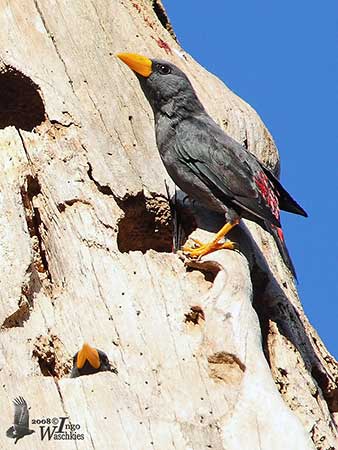
HABITAT:
The Grosbeak Starling is usually found at forest edge and in lightly wooded areas. It also frequents plantations and other modified habitats. This species rarely travels far into dense forest. It can be seen from sea-level to 1,000/1,100 metres of elevation.
CALLS AND SONGS: SOUNDS BY XENO-CANTO
The Grosbeak Starling is usually vocal. It gives a harsh, rasping call “schirr schirr”. They are very noisy while feeding in flocks and at the colonies. During the courtship displays, the male produces long series of chuckling notes interspersed with loud whistles as the displays are progressing.
In flight, the bird produces a liquid “churip” and we can also hear a nasal chatter and a repeated single loud and clear “swee”. They give whistled “wrriu” while feeding in fruiting trees.
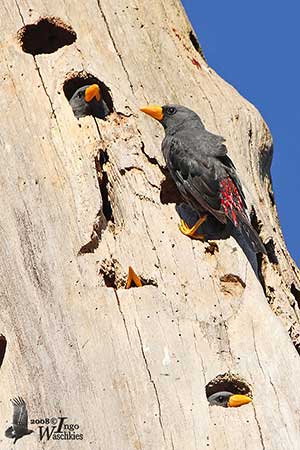
BEHAVIOUR IN THE WILD:
The Grosbeak Starling feeds on fruit, seeds and insects. They often feed in flocks in fruiting trees, including Ficus and Albizzia species, and also Capsicum frutescens of family Solanaceae. This species also feeds on nectar of flowers of Erythrina plant species. They also take seeds and insects.
They are very gregarious and spend most time in upper canopy while feeding in flocks of up to 150 individuals.
During the breeding season, the Grosbeak Starling male performs courtship displays accompanied by song. The male approaches the female while producing series of chuckling notes with fluffed throat feathers. Loud whistles are also heard while the male raises the bill and then, slowly, the entire body into an erect posture. The bird is always whistling with wide open bill and fluffed throat feathers. Then, the head is rapidly lowered while the whole body drops below the horizontal. The male repeats this displays several times.
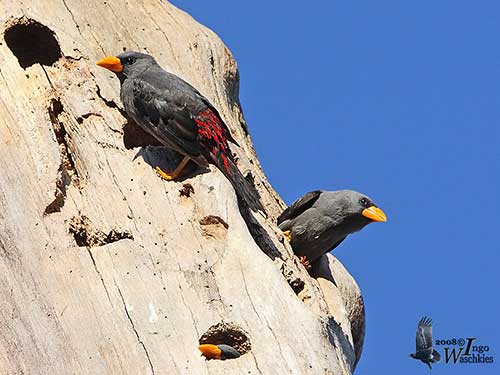
The Grosbeak Starling breeds colonially. These gregarious birds share numerous activities such as feeding, preening, bathing and especially breeding. Each pair defends a small area around the nest. The mates can be often seen in contact, performing mutual preening of head feathers.
The Grosbeak Starling is resident and only performs local movements related to food resources.
They form large flying flocks, swerving quickly before settling down to land.
REPRODUCTION OF THIS SPECIES:
The breeding season takes place in spring (May).
The Grosbeak Starling breeds in colonies that may contain hundreds of nests. Each nest hole is excavated in woodpecker-like fashion, usually in rotten or dying tree trunks. The hole is often 30-40 centimetres in diameter and at least 10 metres above the ground. The cavity is lined with grass and leaves by both mates and can be used all year round for roosting. It is tear-drop shaped with an entrance of about 4 centimetres. Each tree trunk may contain a large number of nests until it collapses, destroying the colony.
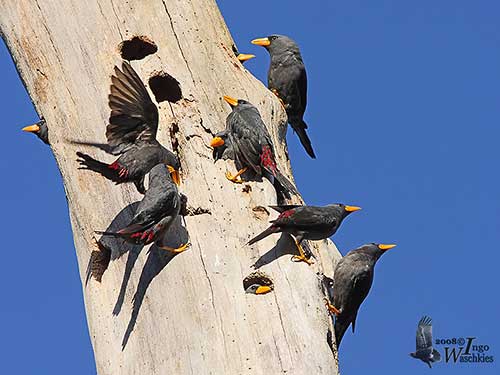
The female lays 2 pale blue eggs with pale and dark brown markings. Both adults incubate during 13-14 days and the chicks are fed by both parents, probably by regurgitation. The nestling period lasts 21-23 days. This species apparently produces one young per nest.
PROTECTION / THREATS / STATUS:
The Grosbeak Starling is common and widespread in its large range, and it is present in several protected areas. In addition, this species breeds readily in captivity.
The population size is unknown, but it is suspected to be declining due to habitat destruction and fragmentation causing the loss of numerous nests.
The Grosbeak Starling is not globally threatened, and the species is currently evaluated as Least Concern.
